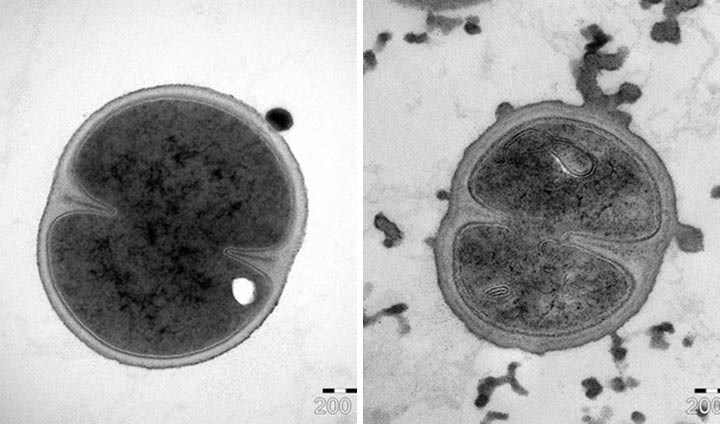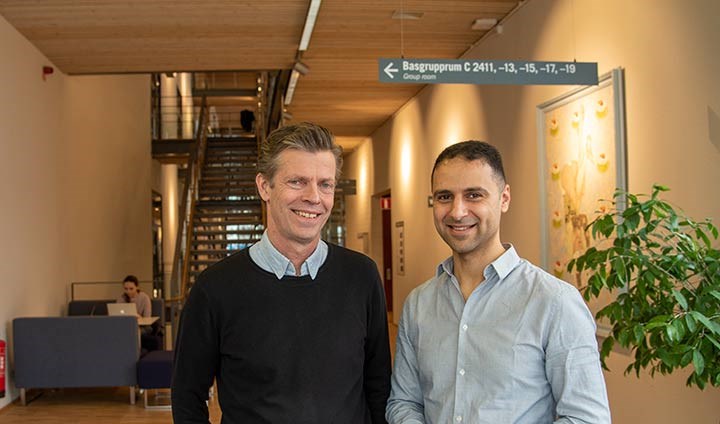Örebro researchers show how a peptide can render antibiotics effective again – at doses 100 times lower than usual

A peptide renders older antibiotics effective again at doses 100 times lower than the common dosage, as shown by research from Örebro University.
“Administering lower doses of antibiotics when treating infections in turn reduces the risk of further development of antibiotic resistance, which today is a major global threat to public health,” says Torbjörn Bengtsson, professor in medical cell biology.
The results of the study, which was conducted by Torbjörn Bengtsson together with his Örebro colleague Hazem Khalaf, docent in cellular microbiology, and researchers at Linköping University, have been published in Nature Scientific Reports.
The scientists have studied how an antibacterial peptide, plantaricin, can be combined with antibiotics to kill bacteria, in this case methicillin-resistant Staphylococcus aureus (MRSA). These bacteria today present a major problem within healthcare, causing difficult-to-treat wound infections, infections linked to catheters and prosthetic implants, and in the worst-case scenario – severe sepsis.
The plantaricin peptide originates from a “good” bacterium and can for instance be found in fermented vegetables, serving as a preservative.

This study shows that plantaricin rapidly affects and dissolves the bacterial membrane and makes it easier for the antibiotics to reach their targets in the bacteria and quickly kill it.
“With plantaricin, the doses of antibiotics required to get a sufficient antibacterial effect is 100 times lower than usual. And lower doses is a good thing since the antibiotics can have toxic side-effects and damage internal organs,” says Hazem Khalaf.
The study shows that a combined treatment with plantaricin and antibiotics can be developed to facilitate rapid and effective prevention of bacterial infections, while also restricting the development of antibiotic resistance.
“Bacteria have over decades developed resistance to conventional antibiotics and pharmaceutical companies have more or less stopped developing new ones. There is simply no profit in it. It can take up to ten years to develop new antibiotics – but it takes bacteria only a few years to establish resistance to the new drug,” says Torbjörn Bengtsson.
“We have tested different types of antibiotics – those that attack the bacterial cell wall and those that enter the bacteria and attack DNA, RNA or a specific protein. Plantaricin seems to work well together with most antibiotics,” says Hazem Khalaf.
The plantaricins dissolve and destroy the bacterial membrane, a layer separate from the cell wall.
“The membrane is a basic structure in the bacterial cell, and has been stable during evolution without major changes. This most likely explains why bacteria do not have the ability to develop resistance to our peptides,” says Torbjörn Bengtsson.
Treating wound infections
The next step is to further develop and make use of the good antibacterial effects of plantaricin within healthcare, primarily by preventing and treating wound infections.
Together with colleagues at Linköping University, Luleå University of Technology and the company S2Medical AB, the Örebro researchers last autumn received a grant of SEK 30 million from the Swedish Foundation for Strategic Research to develop a new type of wound treatment, a project which has been named HEALiX
“Our aim is to develop smart wound dressing materials of cellulose membrane and our plantaricins for treating severe non-healing wound infections,” says Torbjörn Bengtsson.
Another possible application is to coat medical implants with plantaricins before they are implanted, such as hip prosthetises.
Save patients a lot of pain
“If an implant is contaminated by bacteria, a bacterial biofilm is formed that is often extremely difficult, if not impossible, to treat with antibiotics. The only way is to replace the entire implant,” says Hazem Khalaf.
“The solution is a treatment of the implant with our plantaricins, preventing the bacteria from getting hold in the first place to form a biofilm. This would save patients a lot of pain and frustration,” he says.
Torbjörn Bengtsson and Hazem Khalaf hope that the new findings will attract great interest from pharmaceutical companies to develop novel treatment strategies of severe bacterial infections.
Text: Maria Elisson
Translation: Charlotta Hambre-Knight
